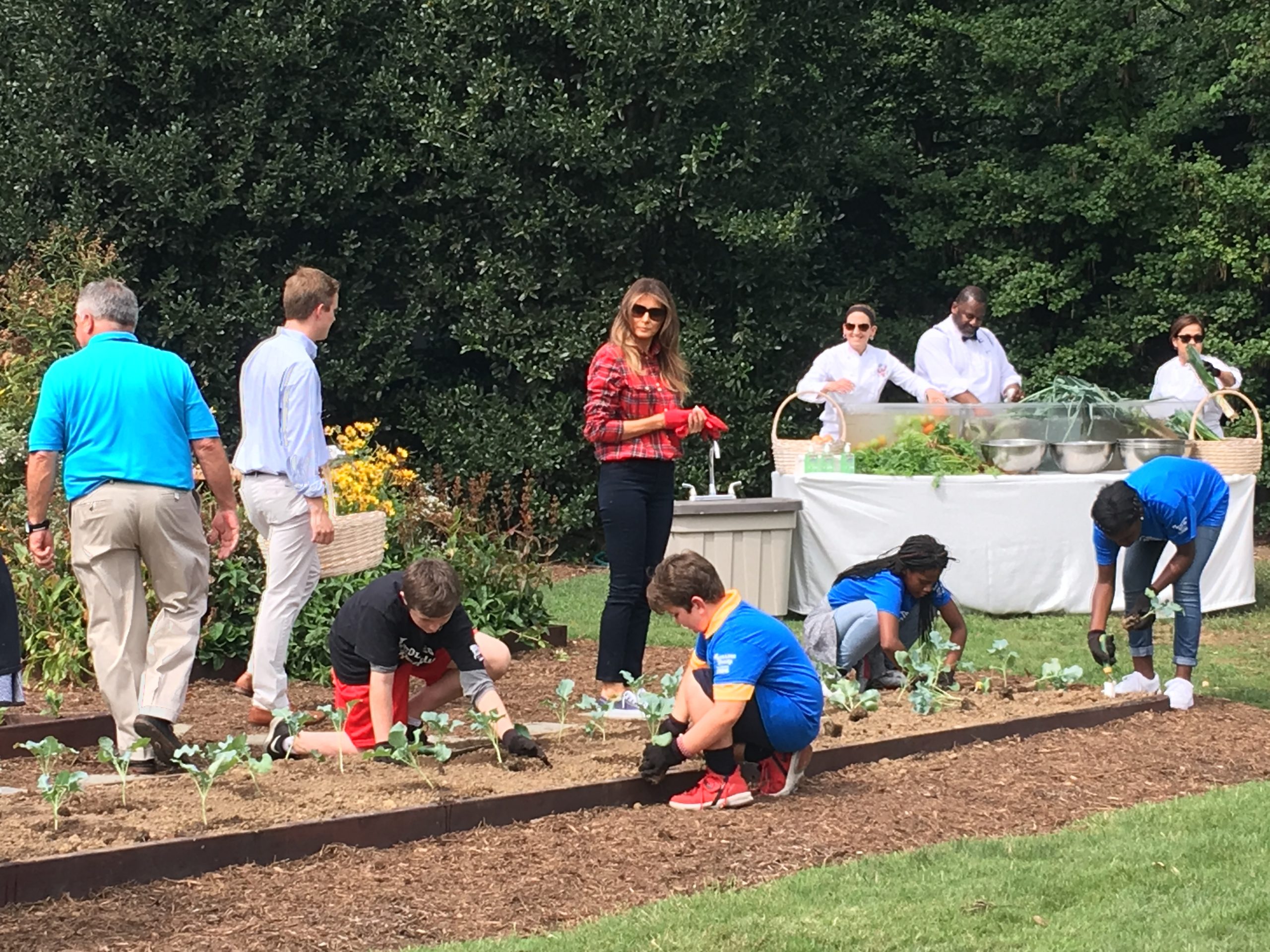First lady Melania Trump welcomed the first day of fall on Friday by harvesting vegetables from the White House Kitchen Garden with a group of children from Washington’s Anacostia neighborhood.
Under a partly cloudy sky and an unseasonably warm 83-degree afternoon, the first lady worked alongside 10- and 11-year-old children from the Boys and Girls Club of the Greater Washington region and National Park Service workers, to snap fresh peas and radishes off plant branches.
She spoke with the children and asked them what their favorite fruits and vegetables are. The kids smiled back, eager to engage the first lady in small talk.
The group cut arugula and Swiss chard at the stem and placed the assortment of green vegetables into wicker baskets before washing everything.
Trump, dressed in a red plaid button-down blouse, blue jeans, and Converse sneakers, spent time with each of the children, moving from one to another and showing them how to plant seeds and pack the soil.
“Come on here and help me,” she asked.

The group planted cabbage, cauliflower, turnips, carrots, kale, spinach, and lettuce, which will fare well in the autumn months thanks to a clear, plastic cover that is placed over the garden beds using metal hoop frames.
The gardening day was Trump’s first since taking over the project from her predecessor, Michelle Obama.
“Healthy, nurturing, and positive environments are instrumental in enhancing the well-being and mindfulness of all children. They learn so much through their surroundings and the White House Kitchen Garden is a prime example of how children can enjoy the outdoors and learn about healthy eating and living, while also gaining an understanding of the White House and its rich history,” Trump said. “I was so happy to be able to celebrate healthy living through fun activities with these special children today, and I look forward to future events in the garden.”
The garden is in its ninth season and its first year in new hands since former first lady Michelle Obama moved away from the White House in January.
Trump and her 11-year-old son, Barron, moved from Manhattan to the White House in mid-June. The first lady’s office announced in mid-February it would keep the kitchen garden as her husband’s administration rolled back various school lunch and related child health policies.

America’s second and third presidents, John Adams and Thomas Jefferson, are both remembered as “garden-loving” leaders who grew fruits and vegetables outside the mansion and used the produce in their meals in the 1790s and early 1800s.
In 1835, President Andrew Jackson stepped up the nation’s garden game and installed a glass hothouse on the property. The see-through structure allowed tropical fruit to grow. It was demolished and replaced with a greenhouse in 1857. By the turn of the 20th century, the greenhouse was taken down to make room for the West Wing.
The presidents’ passions for natural food was carried on through various administrations and was most notably picked up again during World War II when Eleanor Roosevelt championed the Victory Garden in 1943. Following Roosevelt’s departure from the White House, the garden’s fruits and vegetables would not be used for cooking purposes until the next century.
Obama created the current garden on the South Lawn of the White House on March 20, 2009. Out of that project grew the Let’s Move initiative that the former first lady launched to call attention to kids’ diets and combat childhood obesity. Obama was joined by then-White House chef Sam Kass and students from Bancroft Elementary School at the first planting. She said she envisioned the garden as a “learning garden” where kids could put a seed in the Earth and come back months later and see how their work paid off and the plant has blossomed.
The last harvest and planting took place in June and was carried out by the National Park Service and administrators from local schools who have participated in previous garden events.

The produce will be used in the White House kitchen and the remainder will be donated to charity groups in Washington, as is tradition.
At last count, the L-shaped garden has certainly taken root. It was recently documented at 1,700-square-feet in size and provides upwards of 55 types of vegetables, fruits, and spices for the White House kitchen.
The garden’s soil is comprised of organic compost and mulched with straw. Although Trump and her helpers are planting and harvesting vegetables Friday, the garden also normally holds other types of produce, including strawberries, figs, peppers, beans, herbs, garlic, and less popular crops like rhubarb, tomatillos, and ginger.
Approximately 740 pounds of produce was harvested in the garden’s first year and the White House could not estimate how much is expected to be hauled from another fruitful season. a
The garden is funded by Burpee Seeds and a $2.5-million donation from the Burpee Foundation.



